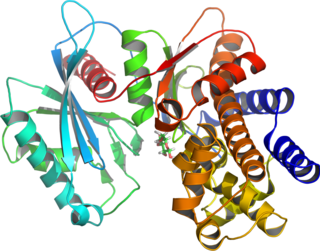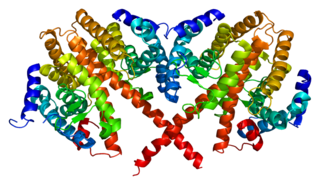HNF1 homeobox B (hepatocyte nuclear factor 1 homeobox B), also known as HNF1B or transcription factor 2 (TCF2), is a human gene.
HNF1 homeobox B (hepatocyte nuclear factor 1 homeobox B), also known as HNF1B or transcription factor 2 (TCF2), is a human gene.
HNF1B encodes hepatocyte nuclear factor 1-beta, a protein of the homeobox-containing basic helix-turn-helix family. The HNF1B protein is believed to form heterodimers with another member of this transcription factor family, HNF1A; depending on the HNF1B isoform, the result may be to activate or inhibit transcription of target genes. Deficiency of HNF1B cause abnormal maternal-Zygote transition and early embryogenesis failure. [5] [6] Mutation of HNF1B that disrupts normal function has been identified as the cause of MODY 5 (Maturity-Onset of Diabetes, Type 5). A third human transcript variant is believed to exist based on such a variant in the rat: however, to date such an mRNA species has not been isolated. [7]

Glucokinase is an enzyme that facilitates phosphorylation of glucose to glucose-6-phosphate. Glucokinase occurs in cells in the liver and pancreas of humans and most other vertebrates. In each of these organs it plays an important role in the regulation of carbohydrate metabolism by acting as a glucose sensor, triggering shifts in metabolism or cell function in response to rising or falling levels of glucose, such as occur after a meal or when fasting. Mutations of the gene for this enzyme can cause unusual forms of diabetes or hypoglycemia.
Maturity-onset diabetes of the young (MODY) refers to any of several hereditary forms of diabetes mellitus caused by mutations in an autosomal dominant gene disrupting insulin production. Along with neonatal diabetes, MODY is a form of the conditions known as monogenic diabetes. While the more common types of diabetes involve more complex combinations of causes involving multiple genes and environmental factors, each forms of MODY are caused by changes to a single gene (monogenic). GCK-MODY and HNF1A-MODY are the most common forms.
HNF4 is a nuclear receptor protein mostly expressed in the liver, gut, kidney, and pancreatic beta cells that is critical for liver development. In humans, there are two paralogs of HNF4, HNF4α and HNF4γ,encoded by two separate genes HNF4A and HNF4G respectively.
Hepatocyte nuclear factors (HNFs) are a group of phylogenetically unrelated transcription factors that regulate the transcription of a diverse group of genes into proteins. These proteins include blood clotting factors and in addition, enzymes and transporters involved with glucose, cholesterol, and fatty acid transport and metabolism.

Hepatocyte nuclear factor 4 alpha (HNF4A) also known as NR2A1 is a nuclear receptor that in humans is encoded by the HNF4A gene.

HNF1 homeobox A, also known as HNF1A, is a human gene on chromosome 12. It is ubiquitously expressed in many tissues and cell types. The protein encoded by this gene is a transcription factor that is highly expressed in the liver and is involved in the regulation of the expression of several liver-specific genes. Mutations in the HNF1A gene have been known to cause diabetes. The HNF1A gene also contains a SNP associated with increased risk of coronary artery disease.

PDX1, also known as insulin promoter factor 1, is a transcription factor in the ParaHox gene cluster. In vertebrates, Pdx1 is necessary for pancreatic development, including β-cell maturation, and duodenal differentiation. In humans this protein is encoded by the PDX1 gene, which was formerly known as IPF1. The gene was originally identified in the clawed frog Xenopus laevis and is present widely across the evolutionary diversity of bilaterian animals, although it has been lost in evolution in arthropods and nematodes. Despite the gene name being Pdx1, there is no Pdx2 gene in most animals; single-copy Pdx1 orthologs have been identified in all mammals. Coelacanth and cartilaginous fish are, so far, the only vertebrates shown to have two Pdx genes, Pdx1 and Pdx2.

Homeobox protein MSX-1, is a protein that in humans is encoded by the MSX1 gene. MSX1 transcripts are not only found in thyrotrope-derived TSH cells, but also in the TtT97 thyrotropic tumor, which is a well differentiated hyperplastic tissue that produces both TSHß- and a-subunits and is responsive to thyroid hormone. MSX1 is also expressed in highly differentiated pituitary cells which until recently was thought to be expressed exclusively during embryogenesis. There is a highly conserved structural organization of the members of the MSX family of genes and their abundant expression at sites of inductive cell–cell interactions in the embryo suggest that they have a pivotal role during early development.

Hepatocyte nuclear factor 4 gamma (HNF4G) also known as NR2A2 is a nuclear receptor that in humans is encoded by the HNF4Ggene.

Pterin-4-alpha-carbinolamine dehydratase is an enzyme that in humans is encoded by the PCBD1 gene.

Peroxisome proliferator-activated receptor gamma coactivator 1-beta is a protein that in humans is encoded by the PPARGC1B gene.

Homeobox protein Nkx-2.2 is a protein that in humans is encoded by the NKX2-2 gene.

MODY 1 or HNF4A-MODY is a form of maturity onset diabetes of the young.
MODY 3 or HNF1A-MODY is a form of maturity-onset diabetes of the young. It is caused by mutations of the HNF1-alpha gene, a homeobox gene on human chromosome 12. This is the most common type of MODY in populations with European ancestry, accounting for about 70% of all cases in Europe. HNF1α is a transcription factor that is thought to control a regulatory network important for differentiation of beta cells. Mutations of this gene lead to reduced beta cell mass or impaired function. MODY 1 and MODY 3 diabetes are clinically similar. About 70% of people develop this type of diabetes by age 25 years, but it occurs at much later ages in a few. This type of diabetes can often be treated with sulfonylureas with excellent results for decades. However, the loss of insulin secretory capacity is slowly progressive and most eventually need insulin.

Renal cysts and diabetes syndrome (RCAD), also known as MODY 5 or HNF1B-MODY, is a form of maturity onset diabetes of the young.

Homeobox protein Nkx-6.1 is a protein that in humans is encoded by the NKX6-1 gene.

Forkhead box protein A1 (FOXA1), also known as hepatocyte nuclear factor 3-alpha (HNF-3A), is a protein that in humans is encoded by the FOXA1 gene.

Forkhead box protein A2 (FOXA2), also known as hepatocyte nuclear factor 3-beta (HNF-3B), is a transcription factor that plays an important role during development, in mature tissues and, when dysregulated or mutated, also in cancer.

Hepatocyte nuclear factor 3-gamma (HNF-3G), also known as forkhead box protein A3 (FOXA3) or transcription factor 3G (TCF-3G) is a protein that in humans is encoded by the FOXA3 gene.

Regulatory factor X, 6 also known as DNA-binding protein RFX6 is a protein that in humans is encoded by the RFX6 gene.
This article incorporates text from the United States National Library of Medicine, which is in the public domain.